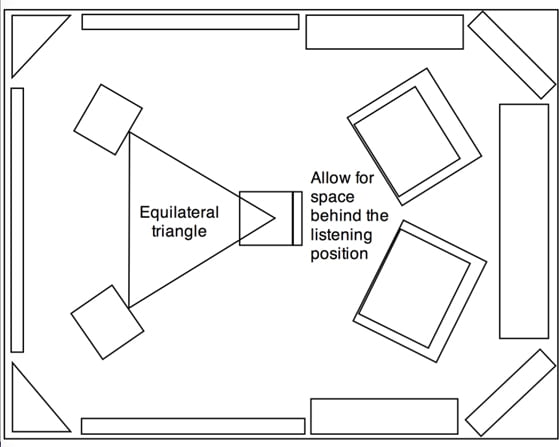It’s the time of year for saving money!
If you’ve been following this DIY acoustics series, you’ve learned several low- or no-cost strategies for improving room acoustics. The solutions in the next two articles will give your bank account a bit of a tug. Those of us with careers in acoustics well know that costs can be prohibitive, but we will still lean toward the more budget-friendly for purposes of this article.
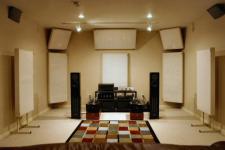 In the industry, form versus function is a hot topic in the design of listening rooms, home theaters, and recording studios. Acoustic companies don’t really compete with other acoustic companies. The competition is between the varied components in a system, customer knowledge and understanding of acoustics, and the challenge of creating acoustic treatments that are also aesthetically pleasing. Fellow acoustician, Anthony Grimani, once opined that if everyone with a high-end audio system treated their room for acoustics, every company in this business would be too busy to keep up with the demand. We estimate that only 5-10% of dedicated audio listening rooms in the U.S. have any acoustic products. Even fewer rooms have products that mitigate the biggest challenge facing audiophiles – bass resonance.
In the industry, form versus function is a hot topic in the design of listening rooms, home theaters, and recording studios. Acoustic companies don’t really compete with other acoustic companies. The competition is between the varied components in a system, customer knowledge and understanding of acoustics, and the challenge of creating acoustic treatments that are also aesthetically pleasing. Fellow acoustician, Anthony Grimani, once opined that if everyone with a high-end audio system treated their room for acoustics, every company in this business would be too busy to keep up with the demand. We estimate that only 5-10% of dedicated audio listening rooms in the U.S. have any acoustic products. Even fewer rooms have products that mitigate the biggest challenge facing audiophiles – bass resonance.
Dealing with bass resonance can be difficult and costly. As the frequency range of a room goes down, treating the anomalies becomes exponentially more expensive. Hence the reason these DIY articles focus primarily on reflections and upper frequencies.
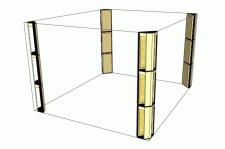 Placement of bass trapping products such as TubeTraps (Acoustic Sciences Corp), The Dimension 4 Spring Trap (MSR Acoustics), RealTraps (RealTraps) and the Alpha Bass Trap (GIK Acoustics), to name a few, are crucial to experiencing the highest performance from a great audio system. As mentioned in a previous article, bass build-up, or bass resonance, and standing waves, are strongest in the tri-corner area of the room.
Placement of bass trapping products such as TubeTraps (Acoustic Sciences Corp), The Dimension 4 Spring Trap (MSR Acoustics), RealTraps (RealTraps) and the Alpha Bass Trap (GIK Acoustics), to name a few, are crucial to experiencing the highest performance from a great audio system. As mentioned in a previous article, bass build-up, or bass resonance, and standing waves, are strongest in the tri-corner area of the room.
Bass builds up in all corners. That’s as true as saying water runs downhill. Stand in a corner and speak in a low register and you can hear it. Slowly walk away from the corner and you will hear the resonance disappear. As low frequency sound waves hit the corners of your room they build up and become overbearing. This not only is evident on the low end, but also causes upper frequencies to sound less pronounced because the overbearing bass is louder and masks the highs.
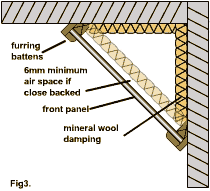 Problems with bass can be not only too much at certain frequencies, but also not enough at others. In article 3, we looked at “peaks and valleys”. If there is a big boost at one frequency, for example, 80Hz (80 cycles per second, approximately a low E string on a guitar [see figure 1]), there may also be a “null” or “suck out” at 160Hz, meaning that note will be weak. Bass trapping in your room corners will tame bass build up, and also bring back the loss of bass at other frequencies. It will make the low end of your system more accurate and make the sound tighter.
Problems with bass can be not only too much at certain frequencies, but also not enough at others. In article 3, we looked at “peaks and valleys”. If there is a big boost at one frequency, for example, 80Hz (80 cycles per second, approximately a low E string on a guitar [see figure 1]), there may also be a “null” or “suck out” at 160Hz, meaning that note will be weak. Bass trapping in your room corners will tame bass build up, and also bring back the loss of bass at other frequencies. It will make the low end of your system more accurate and make the sound tighter.
You will hear the greatest amount of improvement in your room acoustics, by placing bass traps in the corners behind the speakers in the front of your room. The next step is to treat the corners in the rear of the room behind the listener. Often there is more low bass stored in the rear, so using larger bass traps that work lower in the frequency range is, in most cases, ideal. Usually, focusing on the front and rear corners is enough to clean up most of your bass issues. There are other places in the room, for instance the front wall in the dead center, where bass trapping can be beneficial. It will also help focus stereo imaging. Once you have treated the corners with bass traps – the first reflection points with some absorption – and the rear wall with absorption or diffusion, you will see roughly an 80% improvement in your room acoustics. At this point, it’s time to call in professionals to help you with the final tweaking.
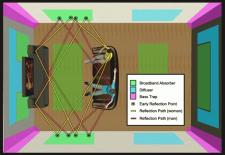 There are many products from reputable companies that work on varying bass trapping principals. There are only a handful of companies that manufacture them, so I encourage you to research and compare the benefits of each. While it is possible to build your own, it’s difficult to do correctly, and not recommended. Given the hours it takes to get it right, and the cost of materials purchased at individual retail, most people find it’s not worth the cost or hassle.
There are many products from reputable companies that work on varying bass trapping principals. There are only a handful of companies that manufacture them, so I encourage you to research and compare the benefits of each. While it is possible to build your own, it’s difficult to do correctly, and not recommended. Given the hours it takes to get it right, and the cost of materials purchased at individual retail, most people find it’s not worth the cost or hassle.
In the final installment, I will discuss how to build a room, or remodel your existing space into an ideal listening environment.
Christopher Klein has been designing and building high end acoustic treatments for listening rooms, studios, and home theatres since 1992. He has also been a professional musician since 1977.
